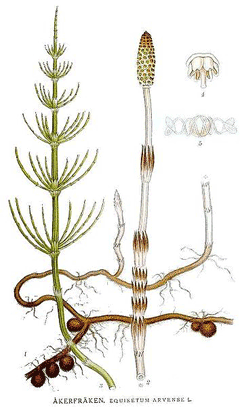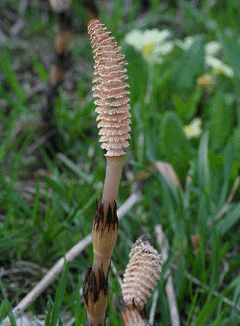 |
|
http://commons.wikimedia.org/wiki/File:515_Equisetum_arvense.jpg |
 |
|
Translate this page:
Summary
Equisetum species - horsetail family are Creeping, perenial, Branching rootstocks, rooted at the nodes. The Arial stems may be annual or Perennial, are cylindrical, fluted, simple or with whorled branches at the jointed nodes. The internodes are usually hollow. The Surfaces of the stems are covered with Silica. The Cones are terminal.
Equisetum avense is a Perennial from creeping rhizomes, often forming large colonies; to 2 1/2 ft. Stems hollow, riged, jointed. Sterile stems green, with whorled branches ar nodes; leaves reduced to brownish, papery, toothed sheath around node; sheath with fewer then 14 teeth. Fertile stems brownish to whitish, with large "cone" at tip, formed by spore-producing scales; cone produced in early spring.
Physical Characteristics

 Equisetum arvense is a PERENNIAL growing to 0.6 m (2ft).
Equisetum arvense is a PERENNIAL growing to 0.6 m (2ft).
See above for USDA hardiness. It is hardy to UK zone 3. The seeds ripen in April.
Suitable for: light (sandy), medium (loamy) and heavy (clay) soils and can grow in nutritionally poor soil. Suitable pH: mildly acid, neutral and basic (mildly alkaline) soils. It can grow in semi-shade (light woodland) or no shade. It prefers dry or moist soil.
UK Hardiness Map
US Hardiness Map
Synonyms
Equisetum calderi. Equisetum saxicola.
Plant Habitats
Meadow; Hedgerow;
Edible Uses
Edible Parts: Root Shoots Stem
Edible Uses:
Strobil (the fertile shoots in spring) - cooked and used as an asparagus substitute[7, 46, 61, 94]. They should be used when young[116] but even so it is probably best to change the water, perhaps 3 - 4 times[85, 102]. One report says that they can be eaten raw[172], they are peeled and the shoot tip is discarded[213]. It is said to be a very tedious operation and they should not be eaten raw in any quantity, see the notes above on toxicity[K]. Some native tribes liked to eat the young vegetative shoots, picked before they had branched out, and would often collect them in great quantity then hold a feast to eat them[257]. The leaf sheaths were peeled off and the stems eaten raw - they were said to be 'nothing but juice'[257]. Roots - raw[61]. The tuberous growths on the rhizomes are used in the spring[172]. The black nodules attached to the roots are edible[257]. It takes considerable effort to collect these nodules so it is normally only done in times of desperation. However, native peoples would sometimes raid the underground caches of roots collected by lemmings and other rodents in order to obtain these nodules[257]. A further report says that the peeled stems, base of the plant, root and tubers were eaten raw by the N. American Indians, the report went on to say that this may be inadvisable[85].
References More on Edible Uses
Medicinal Uses
Plants For A Future can not take any responsibility for any adverse effects from the use of plants. Always seek advice from a professional before using a plant medicinally.
Anodyne Antirheumatic Antiseptic Astringent Cardiac Carminative Diaphoretic Diuretic
Eczema Galactogogue Haemostatic Homeopathy Nervine TB Urinary
Vulnerary
Horsetails have an unusual chemistry compared to most other plants[238]. They are rich in silica, contain several alkaloids (including nicotine) and various minerals[238]. Horsetail is very astringent and makes an excellent clotting agent, staunching wounds, stopping nosebleeds and reducing the coughing up of blood[254]. It helps speed the repair of damaged connective tissue, improving its strength and elasticity[254]. The plant is anodyne, antihaemorrhagic, antiseptic, astringent, carminative, diaphoretic, diuretic, galactogogue, haemostatic and vulnerary[4, 7, 9, 20, 21, 46, 61, 165, 172, 218, 240]. The green infertile stems are used, they are most active when fresh but can also be harvested in late summer and dried for later use[4, 9]. Sometimes the ashes of the plant are used[4]. The plant is a useful diuretic when taken internally and is used in the treatment of kidney and bladder problems, cystitis, urethritis, prostate disease and internal bleeding, proving especially useful when there is bleeding in the urinary tract[4, 238, 254]. A decoction applied externally will stop the bleeding of wounds and promote healing[4]. It is especially effective on nose bleeds[7]. A decoction of the herb added to a bath benefits slow-healing sprains and fractures, as well as certain irritable skin conditions such as eczema[254]. The plant contains equisetic acid, which is thought to be identical to aconitic acid. This substance is a potent heart and nerve sedative that is a dangerous poison when taken in high doses[213]. This plant contains irritant substances and should only be used for short periods of time[238]. It is also best only used under the supervision of a qualified practitioner. A homeopathic remedy is made from the fresh plant[7]. It is used in the treatment of cystitis and other complaints of the urinary system[7]. The German Commission E Monographs, a therapeutic guide to herbal medicine, approve Equisetum arvense for urinary tract infections, kidney & bladder stones, wounds & burns (see [302] for critics of commission E).
References More on Medicinal Uses
The Bookshop: Edible Plant Books
Our Latest books on Perennial Plants For Food Forests and Permaculture Gardens in paperback or digital formats.

Edible Tropical Plants
Food Forest Plants for Hotter Conditions: 250+ Plants For Tropical Food Forests & Permaculture Gardens.
More

Edible Temperate Plants
Plants for Your Food Forest: 500 Plants for Temperate Food Forests & Permaculture Gardens.
More

More Books
PFAF have eight books available in paperback and digital formats. Browse the shop for more information.
Shop Now
Other Uses
Dye Fungicide Liquid feed Musical Paper Polish Sandpaper Scourer
The stems contain 10% silica and are used for scouring metal[4, 7, 20, 94, 102] and as a fine sandpaper[7, 54, 99, 257]. They can also be used as a polish for brass, hardwood etc[94]. The infused stem is an effective fungicide against mildew, mint rust and blackspot on roses[14, 18, 20, 54]. It also makes a good liquid feed[54]. A light pink dye is obtained from the stem[99, 257]. It is yellow-gray according to another report[102]. The plant has been used for making whistles[257].
Special Uses
Dynamic accumulator Food Forest
References More on Other Uses
Cultivation details
Prefers poor dusty ground[53, 54]. This rather contradicts another report which says that the presence of this plant indicates underground water[4]. Prefers a moist but well-drained fertile soil with a pH between 6.5 and 7.5[200, 238]. A very cold-hardy species tolerating temperatures down to about -30°c[200]. Plants have a deep and penetrating root system and can be invasive. If grown in the garden they are best kept in bounds by planting them in a large container which can be sunk into the ground[200]. In garden design, as well as the above-ground architecture of a plant, root structure considerations help in choosing plants that work together for their optimal soil requirements including nutrients and water. The root pattern is fleshy. Thick or swollen - fibrous or tap root [2-1].
References Carbon Farming Information and Carbon Sequestration Information
Temperature Converter
Type a value in the Celsius field to convert the value to Fahrenheit:
Fahrenheit:
The PFAF Bookshop
Plants For A Future have a number of books available in paperback and digital form. Book titles include Edible Plants, Edible Perennials, Edible Trees,Edible Shrubs, Woodland Gardening, and Temperate Food Forest Plants. Our new book is Food Forest Plants For Hotter Conditions (Tropical and Sub-Tropical).
Shop Now
Plant Propagation
Spores - best collected as soon as they are ripe in the spring and surface-sown immediately on a sterile compost. Keep moist and pot up as soon as the plants are large enough to handle. Very difficult[200]. Division. The plants usually spread very freely when well sited and should not really need any assistance.
Other Names
If available other names are mentioned here
Bottlebrush; horsetail; mare's tail; pewterwort; scouring rush; shavegrass; snake grass.Ccommon horsetail; horse pipes. Spanish: cola de caballo del campo; cola de rata (Colombia); equiseto menor; herba estanyera (Colombia). French: prèle des champs. Portuguese: cavalinha-dos-campos. Canada: horse pipes. Chile: helecho. Finland: peltokorte. Germany: Acker-Schachtelhalm; Scharfhalm. Italy: coda cavallina dei campi; coda di cavallo; equiseto comune. Japan: sugina. Netherlands: heermoes; paardestaart akker-. Sweden: Åkerfràken. Yugoslavia (Serbia and Montenegro): rastavic.
Native Plant Search
Search over 900 plants ideal for food forests and permaculture gardens. Filter to search native plants to your area. The plants selected are the plants in our book 'Plants For Your Food Forest: 500 Plants for Temperate Food Forests and Permaculture Gardens, as well as plants chosen for our forthcoming related books for Tropical/Hot Wet Climates and Mediterranean/Hot Dry Climates. Native Plant Search
Found In
Countries where the plant has been found are listed here if the information is available
Weed Potential
Right plant wrong place. We are currently updating this section.
Please note that a plant may be invasive in one area but may not in your area so it’s worth checking.
Although E. arvense is found with many crops it is not competitive with a vigorous crop and therefore has little impact on crop yield. However, it can cause difficulty during grain harvesting by clogging harvesting and threshing equipment with its bulk [1-8].
Conservation Status
IUCN Red List of Threatened Plants Status :

Growth: S = slow M = medium F = fast. Soil: L = light (sandy) M = medium H = heavy (clay). pH: A = acid N = neutral B = basic (alkaline). Shade: F = full shade S = semi-shade N = no shade. Moisture: D = dry M = Moist We = wet Wa = water.

Expert comment
Author
L.
Botanical References
17
Links / References
For a list of references used on this page please go here
Readers comment